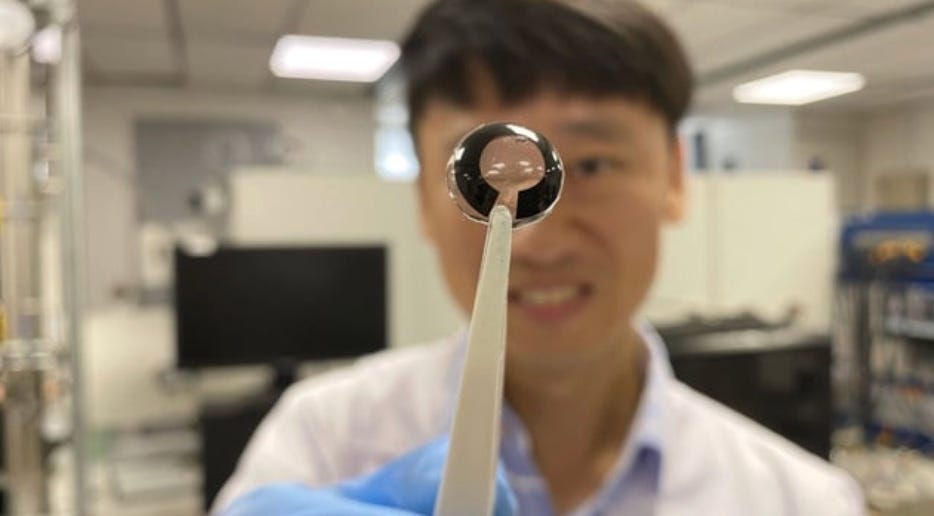This week we look at a new way of powering Smart Contact Lenses. The battery can be recharged by your tears. We examine an energy use reducing paint and we find out how many people it will take to establish a sustainable human colony on Mars. Finally we discover why my dog listens to my wife and ignores me.
Smart Contact Lens
A team at Nanyang Technological University in Singapore have develop a micrometer thin battery that can power a smart contact lens. The battery is recharged with tears.
There are a number of companies trying to develop contact lens that connect to our mobile phones and that can display information right in front of our eyes. The difficulty has been the requirement for the lenses to have a battery. Some have developed lens with induction coils and wires made from metal however this poses a significant risk to the users eyes.
The new battery is not made from metals but biocompatible materials. It is covered in a glucose based coating. The coating can react with sodium and chloride ions within the battery in order to generate electricity. Our tears also contain sodium and chloride ions allowing the battery to be recharged as you wear the lenses. If the battery is running flat just have a little cry and you will be good to go again in no time.
The battery can produce a current of 45 micro amperes and a maximum power of 201 microwaves. This will power the lens for most of the day. The tears can extend the usage by 1 hour for every 12 hours of use. The battery would be fully charged overnight in a concentrated saline solution with glucose, potassium and sodium ions. The current version can go through 200 charge and discharge cycles.
Smart contact lenses can also monitor our health. Diseases like glaucoma and diabetes can be automatically identified at the earliest stages allowing for easier interventions.
Energy Reducing Paint
There have been a number of paints invented in recent years that can reduce the heating and cooling costs of buildings. These paints however only come in silver or grey limiting their applications.
A team at Stanford University have developed a new type of paint that can both retain heat in buildings in winter and cool them in summer. The paint has two layers that are applied separately. An infra red reflective bottom layer that uses aluminum flakes and an ultra thin infrared transparent upper layer. The upper layer uses inorganic nanoparticles that allows the paint to come in a wide range of colors.
To keep heat out the paint is applied to the exterior of the building and roof. Most of the infrared light passes through the the color layer of the paint, reflects off the lower layer and exits as reflected light. It is not absorbed by the building materials as heat.
To keep heat inside, the paint is applied to the inside walls. Again the lower layer reflects the infrared light that is invisible to the human eye. Up to 80% of the high and mid infrared light is reflected by the paint. This allows heat to be kept inside in winter and outside in summer. The paint is water repellant so easy to wash and suitable for humid and wet environments.
The team has tested white, red, blue, yellow, green, orange, purple and dark grey paints. In simulations the paints reduced the energy required for heating by 36% and the energy required for cooling by 21%. The paint may also be useful for trucks and train wagons that transport refrigerated goods. Refrigeration costs make up about half the cost of transport of these goods. Any reduction in cost will be welcomed.
The team is now working on water based solutions which will be more environmentally friendly than the current organic solvents.
Dog Brains and how they hear
When we are trying to communicate with an individual that has limited linguistic competence (e.g. infants and dogs) we speak with a specific speech style that grabs their attention. It is characterized by exaggerated prosody (the rhythm, speed, pitch and relative emphasis that distinguishes various vocal patterns).
This infant directed speech is very important for healthy cognitive, social and language development in very young children. A team at Eotvos Lorand University in Hungary wondered if dog brains were wired the same way.
The team measured dog brains activity via an fMRI . In the MRI, trained, conscious family dogs listened to dog, infant and adult directed speech recorded from 12 women and 12 men in real life interactions. The dogs auditory brain regions responded more to the dog and infant directed speech than to adult directed speech.
Additionally the speech sensitivity of dog brains is more pronounced when the speakers were women. Voice pitch and variation affected the way the dogs responded. The way we speak to a dog does matter. Their brains are specifically sensitive to the exaggerated prosody typical to the female voice.
I thought that our dog ignored me and listened to my wife because she is a far better human than I am. Now I know the it is because her voice varies more than mine.
How many People are required to start a Colony on Mars?
Elon Musk and likely many others are contemplating setting up a colony on Mars. Whilst there are many hurdles to overcome before we achieve such a feat one thing to ponder is how many people is the minimum number that we need to send to successfully establish a colony on Mars?
A team at George Mason University has developed a series of simulations to test how different sizes of colony would survive. They also looked at what characteristics the people on the mission required for success. For example we probably should screen out potential serial killers.
The team used data from past space missions including from the International Space Station and from groups who lived in close quarters in the Arctic for months at a time. The also attempted to factor in known character traits such as resilience to stress, social skills and degrees of neuroticism.
The team ran five simulations which modeled 28 Earth years of life. They changed factors between runs such as the size of the Mars colony. They found that the minimum viable colony was 22 people. Unsurprisingly they found that people with an agreeable personality were not only more likely to survive the mission but to thrive. Again not exactly a surprise. They found that neurotic personalities were more likely to die earlier than others (the cause of death was not stated but we can guess).
If anyone is interested in what laws would apply on Mars, The Outer Space Treaty was signed by 108 nations in 2019. You can find information about it here. The TLDR is that no nation can own space, the Moon or any other body. The Moon Agreement states that the Moon can only be used for peaceful purposes. Interestingly the US is not a signatory to the Moon agreement. I wonder what they have planned?
Paying it Forward
If you have a start-up or know of a start-up that has a product ready for market please let me know. I would be happy to have a look and feature the startup in this newsletter. Also if any startups need introductions please get in touch and I will help where I can.
If you have any questions or comments please comment below.
I would also appreciate it if you could forward this newsletter to anyone that you think might be interested.
Till next week.







Is the dog in the photo testing the battery contact lenses. Eyes are very bright